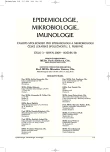Use of PCR in Diagnosis of Enteroviral Infections
Authors:
M. Sojka; S. Bopegamage; A. Petrovičová
Authors‘ workplace:
Oddelenie virológie, Slovenská zdravotnícka univerzita, Bratislava
Published in:
Epidemiol. Mikrobiol. Imunol. 58, 2009, č. 3, s. 132-136
Overview
Enteroviruses belonging to the family Picornaviridae are important human pathogens. Although most cases of infection caused by these viruses are asymptomatic, a wide range of clinical syndromes is observed in manifest cases. Conventional laboratory diagnostic methods based on virus isolation and identification, or on the detection of specific antiviral antibodies, are costly and time consuming. Therefore, they are of little benefit to treatment.
We have implemented a commercially available PCR-based test for the detection of enteroviral infections. In 2008, we analyzed biological specimens from 125 patients with suspected enteroviral disease, most often involving the nervous system.
The presence of enterovirus was detected in 39 patients. The results were compared with those obtained by the conventional methods. PCR appeared to be a valuable method for rapid, accurate and reliable diagnosis of enteroviral infections which is of major benefit to patient management.
Key words:
enteroviruses – PCR – diagnostic.
Sources
1. Ahmed, A., Brito, F., Goto, C. Clinical utility of the polymerase chain reaction for diagnosis of enteroviral meningitis in infancy. J Pediatr, 1997, 131, 393 – 397.
2. Byington, C. L., Taggart, E. W., Carroll, K. C., Hillyard, D. R. A polymerase chain reaction –based epidemiologic investigation of the incidence of nonpolio enteroviral infections in febrile and afebrile infants 90 days and younger. Pediatrics, 1999, 103, E27.
3. Galbraith, D. N., Nairn, C., Clements, G. B. Evidence for enteroviral persistence in humans. J Gen Virol, 1997, 78, 307 – 312.
4. Hyypiä, T., Auvinen, P., Maaronen, M. Polymerase chain reaction for human picornaviruses. J Gen Virol, 1989, 70, 3261 - 3268.
5. Chapman, N. M., Tracy, S., Gauntt, C. J., Fortmueller, U. Molecular detection and identification of enteroviruses using enzymatic amplification and nucleic acid hybridization. J Clin Microbiol, 1990, 28, 843 - 850.
6. Cheng, M. F., Chen, B. C., Huang, T. S., Hsieh, K. S., Chen, S. N., Liu, Y. C. Clinical application of reverse-transcription polymerase chain reaction and intravenous immunoglobulin for enterovirus encephalitis. Jpn J Infect Dis, 2008, 61, 18 - 24.
7. de Leeuw, N., Melchers, W. J. G., Willemse, D. F. M., Balk, A. H. M., de Jonge, N., Galama, J. M. D. The diagnostic value of PCR for the detection of enteroviral infections. Serodiagn Immunother Infect Disease, 1994, 6, 189 – 195.
8. Lim, K. A., Benyesh-Melnick, M. Typing of viruses by combinations of antiserum pools: application to typing of enteroviruses (Coxsackie and echo). J Immunol, 1960, 84, 309 – 317.
9. Muir, P. Enteroviruses and heart disease. Br J Biomedical Sci, 1993, 50, 258 – 271.
10. Muir, P., Kämmerer, U., Korn, K., Mulders, M. N., Poyry, T., Weissbrich, B., Kandolf, R., Cleator, G. M., van Loon, A. Molecular typing of enteroviruses: Current status and future requirements. Clin Microb Rev, 1998, 11, 202 – 227.
11. Muir, P., Nicholson, F., Illavia, S. J., McNeil, T. S., Ajetunmobi, J. F., Dunn, H., Starkey, W. G., Reetoo, K. N., Cary, N. R. B., Parameshwar, J., Banatvala, J. E. Serological and molecular evidence of enterovirus infection in patients with end-stage dilated cardiomyopathy. Heart, 1996, 76, 243 – 249.
12. Muir, P., Nicholson, F., Jhetam, M., Neogi, S., Banatvala, J. E. Rapid diagnosis of enterovirus infection by magnetic bead and polymerase chain reaction detection of enterovirus RNA in clinical samples. J Clin Microbiology, 2003, 31, 31 – 38.
13. Nicholson, F., Meetoo, G., Aiyar, S., Banatvala, J. E., Muir, P. Detection of enterovirus RNA in clinical samples by nested polymerase chain reaction for rapid diagnosis of enterovirus infection. J Virol Methods, 1994, 48, 155 – 166.
14. Ramers, C., Billman, G., Hartin, M., Ho, S., Sawyer, M. H. Impact of a diagnostic cerebrospinal fluid enterovirus polymerase chain reaction test on patient management. JAMA, 2000, 283, 2680 – 2685.
15. Rotbart, H. A., Ahmed, A., Hickey, S. Diagnosis of enterovirus infection by polymerase chain reaction of multiple specimen types. Pediatr Infect Dis J, 1997, 16, 409 – 411.
16. Sawyer, M. H., Holland, D., Aintablain, N. Diagnosis of enteroviral central nervous system infection by polymerase chain reaction during a large community outbreak. Pediatr Infect Dis J, 1994, 13, 177 – 182.
17. Schlesinger, Y, Sawyer, M H., Storch, G. A. Enteroviral meningitis in infancy. Pediatrics, 1994, 94, 157 – 162.
18. Takami, T., Nakayama, T., Kawashima, H., Takei, Y., Takekuma, K., Hoshika, A. Determination of enterovirus serotype inferred from sequence analysis of PCR products. J Clin Virol, 2003, 26, 355 – 359.
19. Verstrepen, W. A., Kuhn, S., Kockx, M. M., van de Vyvere, M. E., Mertens, A. H. Rapid detection of enterovirus RNA in cerebrospinal fluid specimens with novel single-tube real-time reverse trancription-PCR assay. J Clin Microbiol, 2001, 4093 – 4096.
20. Why, H. J. F., Meany, B. T., Richardson, P. J., Olsen, E. G. J., Bowles, N. E., Cunningham, L., Freeke, C. A., Archard, L. C. Clinical and prognostic significance of enteroviral RNA detection in the myocardium of patients with myocarditis and dilated cardiomyopathy. Circulation, 1994, 89, 2582 – 2589.
21. Yerly, S., Gervaix, A., Simonet, V., Caflisch, M., Perrin, L., Wunderli, W. Rapid and sensitive detection of enteroviruses in specimens from patients with aseptic meningitis. J Clin Microbiol, 1996, 34, 199 – 201.
Labels
Hygiene and epidemiology Medical virology Clinical microbiologyArticle was published in
Epidemiology, Microbiology, Immunology

2009 Issue 3
Most read in this issue
- Use of PCR in Diagnosis of Enteroviral Infections
- Apitherapy – the Role of Honey in the Chronic Wound Healing Process
- Waterborne Diseases Outbreaks in the Czech Republic, 1995-2005
- Serological Characteristics of Hantaviruses from Clinical Specimens Analyzed in 1998-2008 in the Department of Virology, Public Health Institute, Ostrava
